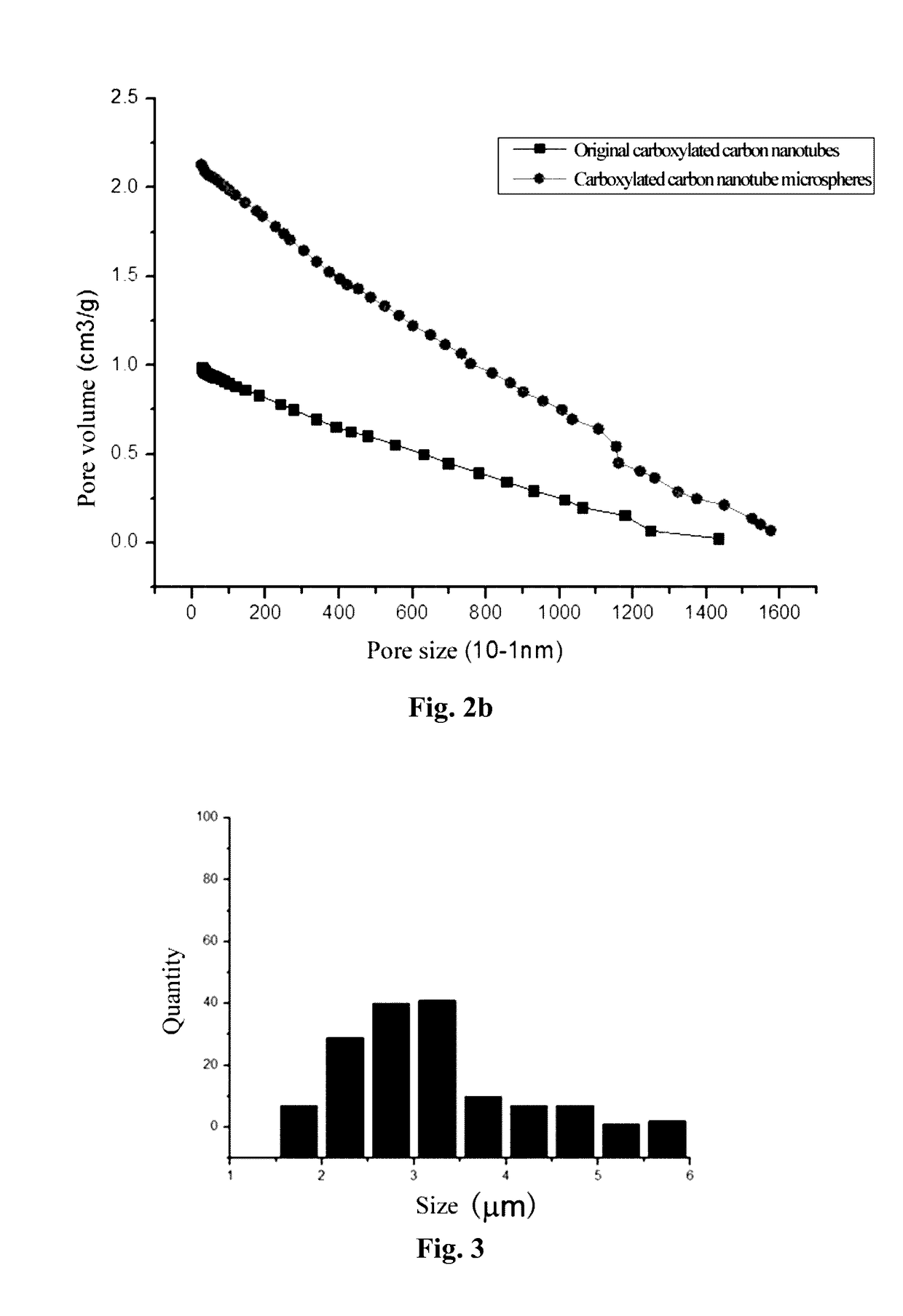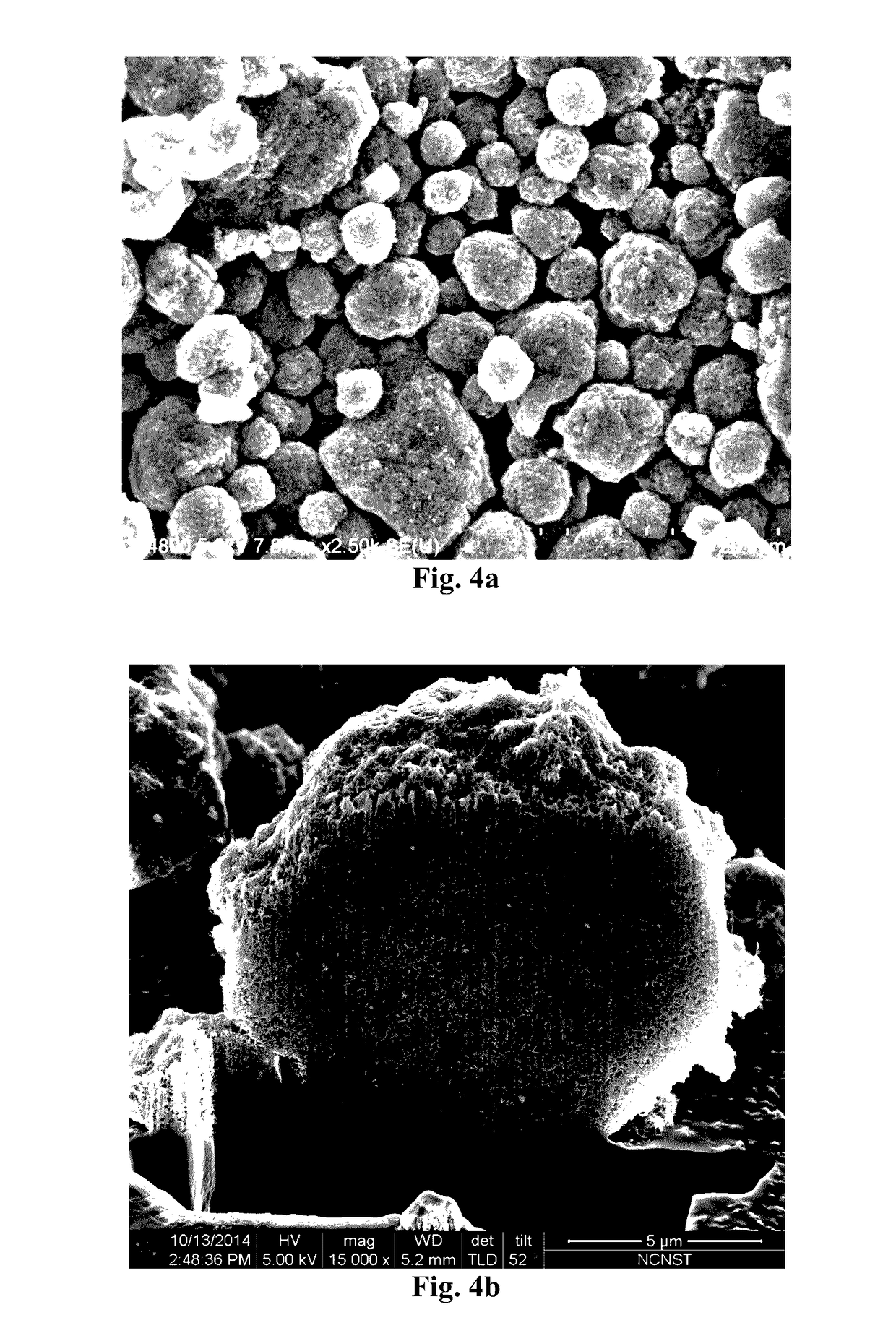Porous carbon nanotube microsphere and preparation method and use thereof, lithium metal -skeleton carbon composite and preparation method thereof, negative electrode, and battery
a carbon nanotube and microsphere technology, applied in the field of material science, can solve the problems of poor safety, difficult to obtain a large number of carbon nanotube microspheres for practical use, and inability to use nanotube microspheres as carrier materials for supporting guest materials, etc., to achieve the effect of high specific capacity, good cycling performance and poor safety
- Summary
- Abstract
- Description
- Claims
- Application Information
AI Technical Summary
Benefits of technology
Problems solved by technology
Method used
Image
Examples
first aspect
Embodiments in First Aspect
[0050]An aspect of the present disclosure provides a porous carbon nanotube microsphere material, which is a material of spherical or spheroidal particles, each particle being composed of carbon nanotubes, wherein a large number of nanoscale pores are formed by interlaced carbon nanotubes inside the particle, and the spherical or spheroidal particles have an average diameter of 1 μm to 100 μm, preferably 1 μm to 25 μm.
[0051]Further, the porous carbon nanotube microsphere material may have any one of a minute spherical solid aggregated structure, a spherical aggregated structure, a spheroidal aggregated structure, a porous spherical aggregated structure, and a donut-shaped aggregated structure, but is not limited thereto.
[0052]Further, the carbon nanotubes may be selected from, but not limited to, any one of multi-walled carbon nanotubes, double-walled carbon nanotube, and single-walled carbon nanotubes, or a combination thereof, preferably multi-walled car...
second aspect
Embodiments in Second Aspect
[0078]The second aspect of this disclosure relates to a lithium metal-skeleton carbon composite, comprising a porous carbon material carrier and lithium metal formed in pores of the carbon material carrier.
[0079]The skeleton structure of the carbon material described above may be a microspherical structure (average pore size of 10 to 50 nm) composed of materials such as carbon fiber, carbon nanotubes, etc., and acetylene black may also be used. Other carbon skeleton materials having an average pore size in a range of 10 to 100 nm may also be used as a carrier for absorbing melted lithium metal.
[0080]The mass of the lithium metal in the lithium metal-skeleton carbon composite comprises typically 5% to 80%, more preferably 30% to 50%.
[0081]Preferably, microspheres prepared by spray drying carbon nanotubes are used as the carbon material skeleton. The microspheres are mainly spherical or spheroidal particles composed of carbon nanotubes, wherein the spherica...
example 1
[0108]4 g of multi-walled carbon nanotubes with a carboxyl content of 3.86 wt % (model JCMT-95-8-20-COOH, Nanjing JCNANO Tech Co., Ltd.) were first added to 200 ml of deionized water, and 20 mL of 37% concentrated aqueous ammonia were further added. The sample was sealed and stirred, and allowed to be uniformly dispersed by performing a ultrasonic treatment with a 130 W ultrasonic probe for 10 hours. After that, the sample was added to a spray dryer (model YC-015, Shanghai Pilotech Instrument and Equipment Co., Ltd.). The air inlet temperature was set at 200° C., the air outlet temperature was set at 150° C., the spray pressure was set at 40 MPa, the feed amount was 500 mL / h, and a carboxylated carbon nanotube microsphere material was obtained after drying. The obtained sample was tested for specific surface area and pore size distribution. A SEM image of the carbon nanotube microsphere material was shown in FIG. 2a, and a comparison diagram of porosities of the carbon nanotube micr...
PUM
 Login to View More
Login to View More Abstract
Description
Claims
Application Information
 Login to View More
Login to View More - R&D
- Intellectual Property
- Life Sciences
- Materials
- Tech Scout
- Unparalleled Data Quality
- Higher Quality Content
- 60% Fewer Hallucinations
Browse by: Latest US Patents, China's latest patents, Technical Efficacy Thesaurus, Application Domain, Technology Topic, Popular Technical Reports.
© 2025 PatSnap. All rights reserved.Legal|Privacy policy|Modern Slavery Act Transparency Statement|Sitemap|About US| Contact US: help@patsnap.com



